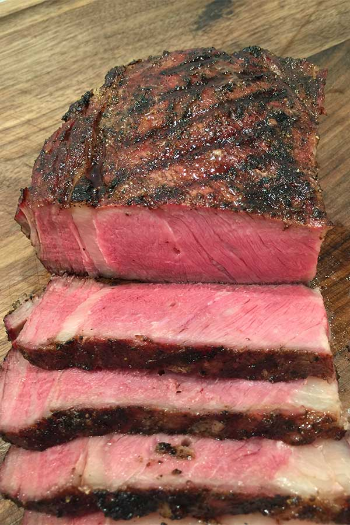The Art of the Reverse Sear: A Culinary Masterpiece
If you're a steak aficionado, you've probably heard of the reverse sear, a culinary technique that can elevate your steak-cooking game to a whole new level. In this article, we'll explore the nuances of the reverse sear and how to execute it flawlessly. From oven settings to resting periods, we'll cover it all. So, get ready to embark on a journey of sizzling, succulent steaks that will leave your taste buds singing.
The reverse searing technique truly shines when it comes to thicker cuts of steak, such as fillet mignon and Tomahawk ribeye steaks. In fact, it's the filet mignon and ribeye that frequently steal the spotlight when discussing the reverse sear method.
As the name implies, this searing approach flips the script on how you'd traditionally sear a steak. Instead of starting with a quick sear on the outer edges and then finishing the cooking process in the oven to reach the desired temperature, you reverse the order: cooking the steak first and searing it second. The outcome? A delectable, freshly browned crust with the perfect texture.
How Do you Reverse Sear a Steak?
Setting the Stage
The reverse sear begins with the right temperature settings. The magic happens in the oven; the first step is to preheat it to the perfect range. For thinner cuts, typically less than an inch thick, set your oven to 110°C. If you're dealing with a thicker-cut steak, more than an inch thick, go for 120°C. This initial step sets the stage for the gradual cooking process that follows.
No Need for Tempering
Traditionally, tempering is a step where you allow your meat to come to room temperature before cooking. However, when using the reverse sear method, this step is not required. The low and slow cooking in the oven eliminates the need for tempering.
Seasoning Savvy
Seasoning your steak is crucial to enhance its flavour, which we do before putting it in the oven. By seasoning in advance, the salt and pepper have time to adhere to the meat and impart their delicious flavours. This pre-seasoning also means the seasoning will have time to meld with the meat, creating a delectable outer layer.
The Art of Elevating
Placing your meat directly on a wire rack is a game-changer in the reverse sear technique. This method allows for better circulation and airflow, ensuring your meat cooks evenly. It also prevents the meat from touching a flat surface, which could conduct heat unevenly.
Patience Is Key
In the world of reverse searing, patience is your best friend. The cooking process typically takes 45 minutes to an hour to reach the desired temperature. But here's the twist: you don't want to cook it to your target temperature in the oven. Instead, aim for a temperature 10°C to 15°C below your desired temperature.
This stage is crucial because it sets the scene for the grand finale. It allows for proper resting, which, in turn, raises the internal temperature. So, when you sear the meat later, it won't overcook. The key to nailing this step is a trusty thermometer.
The Thermometer Check
To ensure you hit the sweet spot, check your meat's temperature after it's been in the oven for about 20 minutes. Then, continue checking every 10 to 15 minutes until you reach your desired temperature. It's a small effort that guarantees a perfect steak.
The Searing Showdown
Now that your meat is primed and ready, it's time to introduce it to some sizzling action. Start by getting your cast iron pan extra hot, as this is the final act in the reverse sear symphony.
Place your beautifully cooked meat on the hot pan and sear each side for about 2 to 3 minutes on medium-high heat. This step is what will give your steak that luscious caramelized crust.
A Final Rest
Your steak has been on quite a journey, and it deserves a moment to itself. After searing, let it rest again for about 10 to 15 minutes. This resting period allows the juices to redistribute within the meat, ensuring a juicy and tender final result.
The Culinary Climax
Now, the moment you've been waiting for - serving and savouring. Your reverse-seared steak is ready to be enjoyed. Slice it open, and you'll reveal perfectly cooked meat with a flavourful crust. Each bite will be a culinary masterpiece.
In conclusion, the reverse sear is a culinary technique that elevates steak cooking to an art form. With the right temperature settings, no need for tempering, proper seasoning, and a patient approach, you can achieve steak perfection. Remember to check the temperature with a thermometer and master the searing process. By following these steps, you'll be creating restaurant-quality steaks in the comfort of your own kitchen. So, get ready to impress your family and friends with your newfound culinary prowess.
Happy cooking, and even happier savouring!
Frequently Asked Questions
What is the Reverse Sear Method?
Many steaks are typically prepared using a grill or a trusty cast-iron skillet. Nevertheless, the reverse sear technique diverges from the norm by delicately slow-cooking the meat at a low temperature in the oven. Following this meticulous cooking phase, the steak is introduced to a sizzling cast-iron skillet, where it acquires that coveted deep, crispy crust that characterizes a superbly prepared steak.
Can you Reverse Sear a 1-inch Ribeye?
The reverse sear method is exclusively suitable for thicker cuts of meat. This crucial detail cannot be emphasized enough; the meat should have a minimum thickness of 1.5 inches for the reverse sear technique to yield favourable results. Attempting the reverse sear on minute steaks or thinner cuts is futile and will inevitably lead to overcooking the meat.
Is it better to Sear or Reverse Sear?
Reverse searing imparts a consistent colour across your steak, offering enhanced precision during the cooking process. If you seek greater culinary control without the complexities of sous vide, opting for a reverse-seared steak represents a favourable middle ground.
 © 2016 University Meat |
© 2016 University Meat |







